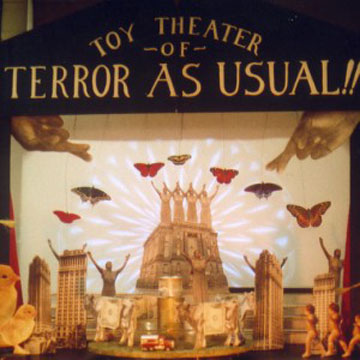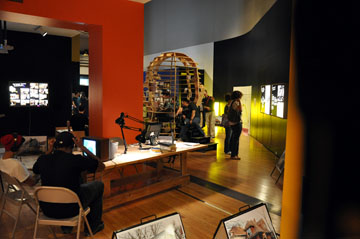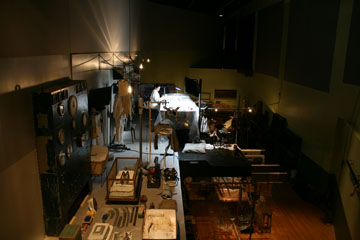
Great Small Works, “The Toy Theater of Terror As Usual, Episode 9: Doom 1996, A photomontage news serial,” created by John Bell, Trudi Cohen, Stephen Kaplin, Jenny Romaine, Mark Sussman, Roberto Rossi. First performed at Performance Space 122, NYC. Photo courtesy of Mark Sussman
In 1934, Supreme Court Justice Louis Brandeis coined the phrase “the curse of bigness” to describe the disastrous effect that concentrated economic power can have on small business, communities, and citizen-led governments. For Brandeis and other Progressive-era crusaders, the “curse’ was monopolies like the New Haven Railroad and robber baron JP Morgan.
Curated by Larissa Harris, The Curse of Bigness at the Queens Museum of Art (May 16 – October 13, 2010) heeds Brandeis’s advice, reflecting the dangers of present-day behemoths. Avoiding didacticism, the show engages with a broad range of DIY strategies, culled from art world insiders like Dennis Oppenheim, to downtown theater mainstays Great Small Works, to West Coast wizards of destruction, Survival Research Labs. Presented here are not aesthetic objects to be contemplated from afar, but rather strategies to determine the scope of what can be accomplished on a human, more sustainable scale.

Damon Rich, “Red Lines Housing Crisis Learning Center,” installation view at the Queens Museum of Art (May 10 – September 27, 2009). Photo: Damon Rich.
In the search for solutions, disciplinary distinctions are ceded to innovative tactics. Harris’s first exhibition at the Queens Museum, Damon Rich’s Red Lines Housing Crisis Learning Center, crossed the boundaries of architecture, education, and activism to explore the relationship between redlining practices and the recent foreclosure crisis. The project originated at MIT’s Center for Advanced Visual Studies (CAV) where Harris served as Associate Director before taking her post at the Queens Museum. Using its position within a research institution to commission projects by artists such as Michael Smith, John Malpede, and Simon Starling, MIT’s CAV encouraged artists to investigate new ways of thinking about how information is introduced to the world.
[youtube:https://www.youtube.com/watch?v=YQ02z2U6dw8]
The Curse of Bigness channels this drive towards research, interdisciplinarity, and problem-solving. Interspersed throughout the museum, it maintains the feel of multiple discussion platforms, models, or research laboratories rather than a single exhibition. In the can’t-get-enough-of-it video B-U-S-I-N-E-S-S (2010), hip-hop artist Tara De Long translates her rants about conspicuous consumerism, usually made for a club audience, into video, while artist, researcher, teacher and fashion designer J. Morgan Puett channels the look and feel of her agrarian research institute, Mildred’s Lane, into a workshop/archive/installation. Although these projects could not be any more dissimilar in their tone or approach, they share a common urgency—that something is amiss, something must be done about it, it must happen right now, using whatever tools necessary. It is this spirit of bricolage, of using whatever materials at hand to transform or improve a given situation, that unites the exhibition.
Several months ago, I attended the class, Foresight is 2010, taught by FEAST founder Jeff Hnilicka at the storefront project TradeSchool, where we discussed the resurgence of analog technologies and mercantile exchange. FEAST’s tactic—using community dinners to fund sustainable art projects—draws on barn-raising tradition for grassroots art support that, like InCUBATE’s Sunday Soup in Chicago, have been funding art outside of institutions for years. Two trend forecasters in attendance one from Nokia and another from an environmental consulting firm—suggested that Hnilicka was spot-on in suggesting that people are beginning to reconsider their relationship to technology. Not that they wish to become neo-Luddites, but rather some artists are using the current economic moment to consider the ever-expanding role of technology and whether it has begun to exceed our own human technology (aka the body). It is these themes that are at the root of Italian theorist Bifo’s writing about the contemporary relationship between work and alienation.
At a 16Beaver event to discuss the publication of Art Work, a newspaper about labor, art and economics, artist Lize Mogel asked participants to create a pie chart mapping their income and another mapping their output. Whether made by an artist, curator, or art educator, each map of output revealed the overwhelming amount of time everyone spent on email. It seems that the urge to be in constant contact, to covet the fastest gadget, to work at any given hour—this is the present day curse.
If design is about solving problems, then perhaps art may be about creating them. Embracing Thanatos as much as Eros, the works in The Curse of Bigness do not propose simple solutions or easy outcomes. Just as Art21 Season One artist Andrea Zittel has espoused a motto of “liberation through limitation,” the artists here seem to suggest that smaller or fewer really ain’t so bad.




